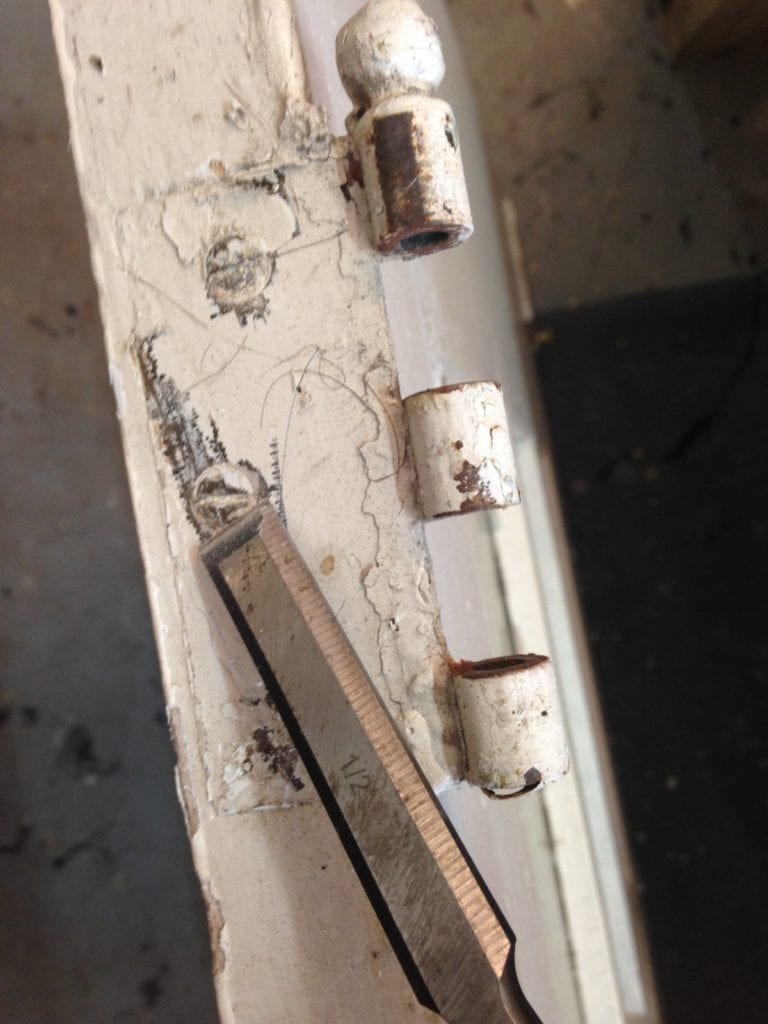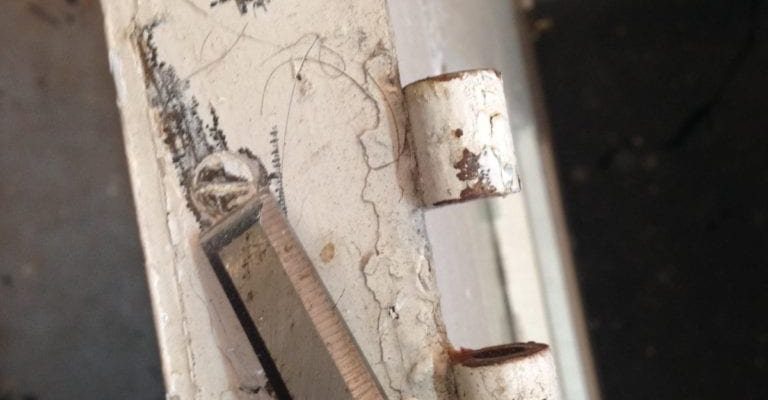
There’s good news, though. With the right tools and a little know-how, you can tackle even the most stubborn corroded screws. I’ve been down this road more times than I’d like, and over the years, I’ve tried everything from brute force to clever gadgets. Some tools really do make all the difference. Let me walk you through which ones work best—and why—so you can finally get your exterior hinges free and avoid making things worse.
Why Corroded Screws Get Stuck in Exterior Hinges
If you’re wondering why those screws won’t budge, it’s not just bad luck. Exterior hinges are on the front lines: they face rain, snow, humidity, and big changes in temperature. That means metal-on-metal contact and a lot of chances for moisture to sneak in. Over time, the screws react with the hinge or the wood/metal around them, leading to corrosion and even rust.
The threads of the screw can bond with the hinge or door frame. Sometimes they swell, locking up like someone welded them in place. Often, bits of debris or old paint get packed in around the screw head, making things even harder. If you try to force a screwdriver at this point, the head might just strip, turning your afternoon job into a full-on project.
Honestly, knowing *why* the screws are stuck can help you work smarter—not just harder. You’ll understand why it matters to use the right tool for the job, rather than just grabbing pliers and hoping for the best.
Penetrating Oils: The First Line of Attack
Before you reach for any heavy-duty tools, the smartest first move is a good penetrating oil. Think of it like WD-40 or PB Blaster—these formulas are designed to sneak into tiny spaces, break up rust, and loosen the bond between metal pieces.
- WD-40 is a classic. It works on some stuck screws, especially if the corrosion isn’t too deep.
- PB Blaster (or Liquid Wrench) is made specifically for tough, rusted hardware. It tends to beat WD-40 for really old, weathered screws.
The trick is patience. Spray the oil directly onto the screw head and give it time—at least 10–15 minutes, or even longer for really corroded screws. Sometimes you’ll need to reapply a couple of times. When you finally try turning the screw, you’ll be surprised how much easier it can move.
Always let the oil soak in. Rushing here won’t do you any favors.
If you’re dealing with a painted-over screw or lots of debris, gently chip away the paint around the screw head before applying the oil. It’ll help the lubricant reach the threads and actually do its job.
Manual Screw Extractors: When the Head Is Stripped
Here’s the thing—sometimes the screw head is so damaged that no screwdriver or drill bit can grip it. That’s where a manual screw extractor comes in handy. These tools have a reverse-threaded tip. You drill a pilot hole into the damaged screw, insert the extractor, and as you turn it counterclockwise, it *bites* into the metal and backs the screw out.
Using a screw extractor sounds tricky, but it’s actually simple if you follow the steps:
- Pick a drill bit slightly smaller than the extractor you’ll use.
- Drill a shallow hole in the center of the screw head. Go slow and steady—it doesn’t have to be deep.
- Gently tap the extractor into the hole with a hammer.
- Turn the extractor counterclockwise using a wrench or T-handle. The screw should start to turn out of the hinge.
Screw extractors are lifesavers, especially when you’d rather not make a mess or damage the door or hinge. Brands like Irwin and Craftsman make excellent kits, and having one around means you’re ready when a screw inevitably gives up the ghost.
Impact Drivers: Adding a Punch to Your Effort
Sometimes a regular screwdriver just isn’t enough torque. If you’re tired of slipping and stripping screws, an impact driver can be a real game-changer. Unlike a normal drill, impact drivers deliver short, powerful bursts of force while turning—that “impact” action is what helps break free stubborn corroded screws.
What makes an impact driver so good for exterior hinges?
- The hammering motion helps unstick rusted threads without needing constant, hard pressure.
- You don’t have to press as hard, which reduces wrist fatigue and the risk of stripping the screw head even more.
- Most models, like DeWalt or Milwaukee, have variable speed and torque settings for better control.
If you’re worried about battery life, most cordless models today last long enough for any hinge job and come with swappable batteries. Just make sure you’re using the right bit—one that fits snugly in the screw head. A little extra care setting up means you don’t turn a stuck screw into a permanent part of your door.
Vise-Grip Pliers: Grabbing What Others Can’t
Let me explain why Vise-Grip pliers (sometimes called locking pliers) are such a clutch tool for this job. When the screw head is stripped so badly that nothing fits, these let you grab onto what’s left and twist with serious force.
Here’s how to use them (without wrecking your hardware):
- Set the pliers’ jaws so they clamp tightly around the screw head.
- Lock the grip, then turn the pliers counterclockwise. If it feels frozen, gently rock back and forth to break the bond.
- If the screw head is buried or flush with the hinge, try tapping a flathead screwdriver under it first to create a little lip to grip.
Honestly, I’ve saved so many projects with a pair of Vise-Grips—especially when every other tool fails. They’re strong, they double as a clamp, and they give you leverage that your hands alone just can’t match.
Heat Guns and Soldering Irons: Breaking the Rust Bond
You might be wondering, “Why would I use heat?” The answer is simple: heat can expand the metal, break up corrosion, and help the screw release from the hinge or frame. When a screw is truly welded in place by rust, a heat gun or soldering iron is sometimes your best friend.
Here’s the safe way to do it:
- Set the heat gun on a low-to-medium setting, or use a soldering iron directly on the screw head.
- Apply heat for one to two minutes. The goal is to warm the metal, not to scorch it or burn paint.
- Let the area cool slightly, then try loosening the screw with a screwdriver or impact driver.
Be careful with heat around painted wood or flammable materials. Protect the area with aluminum foil if needed. This approach works wonders, but use it as a last resort—especially if you’re worried about damaging finishes or nearby hardware.
Drill Bits for Drilling Out Screws: The True Last Resort
When all else fails, sometimes you just have to drill out the stubborn corroded screw. This means using a metal drill bit to remove the screw head entirely, allowing you to pull off the hinge and grab the screw shaft with pliers or a screw extractor.
Not gonna lie—this can get messy, but sometimes it’s the only way forward.
- Start with a small pilot bit to keep things centered, then switch to a bit that matches the diameter of the screw head.
- Drill slowly and don’t force the bit—let it do the work. Too much pressure can break the bit or damage the hinge.
- Once the head is gone, remove the hinge and deal with the screw shank sticking out of the door or frame.
Brands like Bosch and DeWalt make drill bits tough enough for this job. Just don’t forget safety glasses—a stray metal shaving in the eye is nobody’s idea of a good day.
Comparing Tool Options: What’s Best for You?
Choosing the best tool for removing stubborn corroded screws from exterior hinges really depends on your specific situation. Let’s break down the main options side-by-side:
| Penetrating Oil | Easy, cheap, and safe for most surfaces. Best for screws with minor-to-moderate rust. Sometimes not enough for deeply corroded hardware. |
| Screw Extractors | Great for stripped heads. Requires drilling a pilot hole, but saves the hinge and wood around the screw. |
| Impact Drivers | Lots of power and torque with less effort. Best if you have a compatible battery and bits. Can strip screws if you’re not careful. |
| Vise-Grip Pliers | Perfect when the screw head is exposed but stripped. Not helpful if the screw is fully buried. |
| Heat Guns/Soldering Irons | Breaks up the toughest rust bonds. Use with caution to avoid damaging finishes or surrounding material. |
| Drill & Bit | Last resort. Removes screw heads cleanly but often damages the hinge or paint. |
If you just want a quick fix and don’t mind a little mess, go for the drill. But most folks prefer to try oil and extractors first. A good impact driver is a worthy investment if you regularly maintain exterior doors or gates.
Tips for Preventing Stuck Screws in the Future
Now that you’ve battled the beast, let’s keep it from coming back. A few simple habits can save you from fighting with corroded screws ever again.
- Use stainless steel or coated exterior screws. They resist rust much better, especially in wet climates.
- Apply a dab of anti-seize or silicone lubricant to the screw threads before installing. This keeps moisture out and makes future removal a breeze.
- Touch up any exposed metal or chipped paint around your hinges. Sealing up those gaps helps prevent water from sneaking in and starting the corrosion process.
Regularly check your exterior hinges and screws. If you spot rust forming, deal with it sooner rather than later. It’s always easier to fix a little problem than a big one.
Corroded screws are a pain, but a bit of prevention makes them a lot less likely to ruin your day down the road.
Wrapping Up: Take the Right Approach and Tools
Getting stuck (literally) on a corroded screw can feel like the world’s most annoying puzzle. But you’ve got a toolbox full of solutions now—from simple sprays like WD-40 and PB Blaster, to muscle-saving impact drivers, trusty Vise-Grips, extractors, and even heat if you need it. The best approach is always to start gentle and work your way up; you don’t want to damage your door, hinge, or hands if you can help it.
Honestly, a little patience and the right tool are the real game-changers here. Next time you’re faced with a stubborn screw on an exterior hinge, you’ll know exactly what to reach for—and how to win the battle without making things worse.
